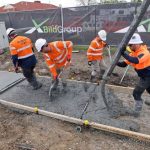Concerning new home approval data has builders ringing alarm bells for looming national construction targets.
This week’s figures from the Australian Bureau of Statistics (ABS) once again have Aussie builders up in arms after it revealed the total number of home approvals had sunk a further 6.1 per cent over last month’s figures.
Despite a 0.6 per cent rise in detached house building approvals, taking the number to a two-year high, the small gain was overshadowed by a sharp 17.5 per cent reduction in approvals for higher-density homes.
Master Builders Australia (MBA) Chief Economist Shane Garrett said these figures meant “the volume of approvals is now even lower than it was a year ago”, casting doubt over whether the residential sector could ever make up the shortfall needed to meet the Albo’s lofty promise of 1.2 million homes by 2029.
“Over the past year, a total of 166,230 new homes have been approved across Australia. If we remain stuck at this rate of new home building over the lifetime of the National Housing Accord, only about 832,000 new homes will get delivered,” said Garrett.
“This would represent a shortfall of over 365,000 homes relative to the 1.2 million new home target set by all levels of government for the Accord.”
With those targets touted by government officials as the key to boosting Aussie home supply and easing the housing crisis, MBA CEO Denita Wawn said that the high-density data wasn’t painting a pretty picture of the economy going forward.
“If we are to bring about a quick end to the housing crisis, we need a strong and consistent supply of high-density housing to the market,” she said.
“It’s disappointing to see such a decline in high-density approval numbers taking our housing supply in the wrong direction.
“With higher density building approvals lower now than a year ago, today’s data reinforces the need for serious action on inflation to encourage new homeownership and more private investors into the market to generate urgently needed new homes.
“Delivering greater volumes of new housing at lower cost and at a faster pace will help bring inflation under control sooner and help to ease economic strains for Australians.”
A slow road to recovery
But there is some hope yet. Despite the dip, house approvals in the three months leading up to August did clock in at 11.2 per cent higher compared to the same time last year, leading Housing Industry Association Chief Economist Tim Reardon to believe the market was on the mend.
Putting the worrying high-density figures down to “rising tax imposts on foreign investors and rising regulatory costs”, Reardon said that stabilising costs had confidence returning to the other industry sector.
“It has been almost eleven months since the last increase in the cash rate. Stable interest rate settings have provided the certainty needed to see a rise in home-building confidence,” he said.
“This is complemented by stabilising price growth for building materials, a return to normal build times, strong housing demand and low unemployment.
However, with plenty more work to be done to get home builders back on track, Reardon once again called on government officials to ease the financial barriers barring many Aussies from adding to the housing supply.
“The government’s focus should be on lowering the taxes, regulatory costs and excessive charges that make up as much as 50 per cent of the final cost of a house and land package,” he said.
“Recent discussions on negative gearing and capital gains tax arrangements for residential property will undermine confidence in new home building.”







